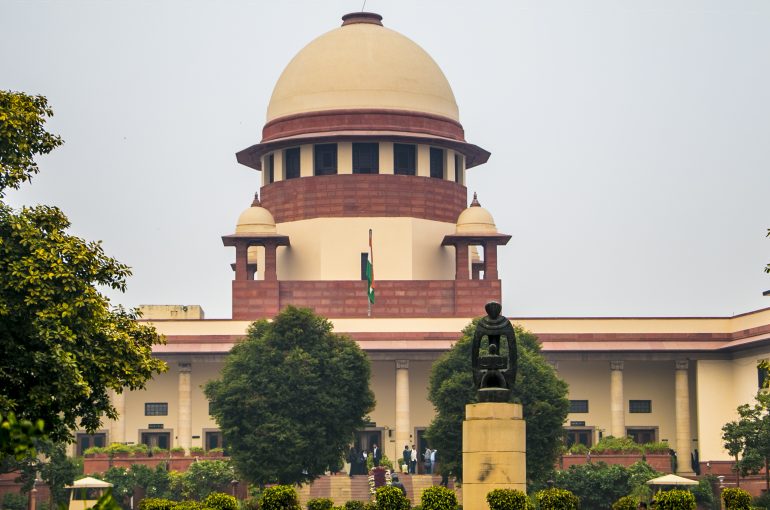SUPREME COURT HOLDS THAT MERE PRESENCE OF VICTIM’S BLOOD GROUP ON THE WEAPON IS NOT A SUFFICIENT GROUND TO CONVICT THE ACCUSED

Introduction:
Criminal jurisprudence requires that the guilt of the accused be established beyond reasonable doubt, especially in cases where the conviction is solely based upon circumstantial evidence. The Supreme Court in the case of State of Rajasthan v. Hanuman [(Criminal Appeal No. 631 of 2017), decided on 19.06.2025] reiterating this principle, dismissed the Appeal filed by the State of Rajasthan challenging the Acquittal Order of the accused granted by the High Court of Rajasthan. The Bench consisting of Justice Sandeep Mehta and Justice P.B. Varale, noted that the two primary circumstances relied upon by the Prosecution, namely, the alleged motive and the recovery of a blood-stained weapon, do not constitute as a complete chain of circumstances to convict the accused. The Court reaffirmed that where there is any missing link in the chain of circumstances, the benefit of doubt must go to the accused.
Facts of the case:
The Accused was charged for the murder of one Chotu Lal, which occurred during the night of 1st March, 2007 and 2nd March, 2007. An FIR was initially lodged against unknown perpetrators. The Accused was subsequently apprehended based on suspicion and circumstantial evidence. The Prosecution alleged that the motive for the murder was the Accused’s inappropriate interest in the wife of the deceased. It was further submitted that the FSL Report indicated the presence of blood on the recovered weapon matching the blood group of the victim.
Relying on this evidence, the Trial Court convicted the Accused under Section 302 of the Indian Penal Code, 1860, sentencing him to life imprisonment along with a fine of Rs. 100/-, in default of which, the Accused was to undergo a further three months of simple imprisonment. The Accused challenged the said conviction before the High Court, which acquitted him on the ground that the prosecution had failed to establish a complete chain of circumstances, as required in cases based on circumstantial evidence. Aggrieved by the acquittal, the State of Rajasthan preferred an appeal before the Hon’ble Supreme Court.
Issues:
- Whether the circumstances relied upon by the prosecution are sufficient to form a complete chain of circumstance?
- Whether the accused can be convicted based on the presence of the victim’s blood group on the recovered weapon?
Analysis:
The Hon’ble Court, while pronouncing the Judgment, observed that the circumstances relied upon by the prosecution were insufficient to hold the accused guilty of murder. The prosecution alleged that the motive for the crime was the Accused’s inappropriate interest in the wife of the deceased. However, the evidence presented in that regard was considered as ‘vague and vacillating’ by the Court.
Secondly, the prosecution relied on the FSL report, which indicated that the weapon recovered at the instance of the accused bore blood stains consistent with blood group of the deceased. In this regard, the Hon’ble Court referred to its earlier judgment of Raja Naykar v. State of Chhattisgarh, (2024) 3 SCC 481, wherein it was held that the mere recovery of a blood-stained weapon, even if it matches the victim’s blood group, cannot form the sole basis for a conviction of murder. The Court in Raja Naykar’ case further reaffirmed the application of the five cardinal principles, commonly known as the Panchsheel Test, laid down in Sharad Birdhichand Sarda v. State of Maharashtra, (1984) 4 SCC 116, which govern the standard to convict the accused solely on circumstantial evidence.
The 5 principles of the Test are:
- The facts forming the basis for inferring the accused’s guilt must be clearly proven.
- The established facts must point solely to the guilt of the accused and should not be capable of being interpreted in any other manner.
- The circumstances should be decisive in nature.
- They must eliminate every possible hypothesis except the one that affirms the guilt of the accused.
- The chain of evidence must be so complete that it rules out any reasonable doubt regarding the innocence of the accused and leads to the conclusion that, in all human probability, the offence was committed by the accused.
The Supreme Court rightly held that mere presence deceased’s blood group on the recovered weapon is not a sufficient ground for conviction, particularly when the chain of circumstances has not been established conclusively. The presence of a matching blood group alone does not necessarily prove that the blood belonged to the victim, as many individuals may share the same blood type. Therefore, such a match cannot definitively connect either the victim or the accused to the crime. The existence of gaps in the chain of circumstances and the possibility of multiple hypothesis mean that the Prosecution has failed to establish the Accused’s guilt beyond reasonable doubt.
The Court further emphasized that the Supreme Court can only interfere with an order of acquittal if the evidence clearly points to the guilt of the accused. In the present case, since the Prosecution failed to prove its case beyond reasonable doubt, the Court upheld the High Court’s view, affirming the innocence of the accused.
Conclusion:
Indian Courts have time and again underscored the importance of conclusive chain of circumstance to convict the accused. They have emphasized that suspicion, no matter how grave, cannot replace proof. The Supreme Court of India has consistently held that simply recovering a weapon with blood stains matching the victim’s blood group does not amount to definitive proof of the accused’s guilt. The prosecution is bound to establish a complete chain of circumstances. This cautious approach of the Judiciary reflects the foundational principle of Indian criminal law, that no innocent person should be wrongfully punished and upholds the presumption of innocence.
SOUJANYA V KULKARNI
INTERN, 5TH YEAR
ICFAI LAW SCHOOL, HYDERABAD
Please log onto our YouTube channel, The Indian Lawyer Legal Tips, to learn about various aspects of the law. Our latest Video, titled Uniform Civil Code Explained | Pros, Cons & Constitutional Perspective | Advocate Sushila Ram Varma| can be viewed at the link below:





































Leave a Reply